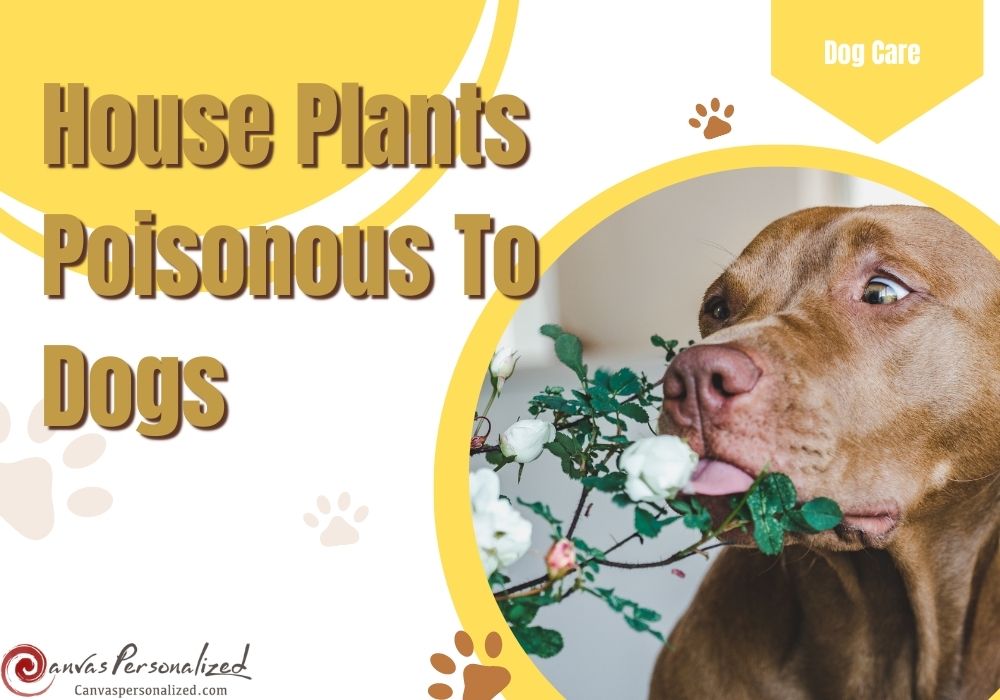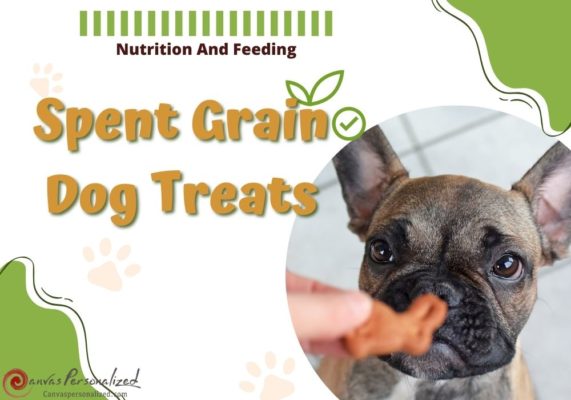As a responsible pet owner, you must understand which house plants poisonous to dogs. While indoor plants are great for aesthetics and air quality, some could harm your pup. Keep reading this article from Canvas Personalized to learn how to avoid or keep your dog safe if you have any of the below plants in your home.
What Are House Plants Poisonous?
According to the ASPCA’s reports, thousands of plants can be toxic to pets if dogs ingest them. Some are minor, others are more serious, and some can even be fatal. Toxic compounds in houseplants can injure dogs in several ways, including ingestion and skin or eye contact with the plant’s sap. Alkaloids, saponins, oxalates, and other hazardous compounds can be found among these toxic substances.

Poisoning from these plants can cause many symptoms, including nausea, vomiting, diarrhea, drooling, lethargy, tremors, seizures, and even death in extreme situations. Pet owners should be aware of the dangers posed by these plants and store them safely out of their pets’ reach.
List Of 10 House Plants Poisonous To Dogs And Symptoms
1. Sago Palm
Despite its beauty, the sago palm is one of the most popular house plants poisonous to dogs. Even though they look like palm trees on the outside, sago palms are cycads, which are ancient seed plants characterized by a thick trunk and a “crown” of large, pinnately compound leaves.

All parts of the sago palm plant are highly toxic. The seeds (nuts) are the most poisonous part, though. Cycasin, a poison found in the plant, can damage the liver if consumed in large quantities. Cattle should also avoid ingesting sago palms.
Nonetheless, due to their exotic appearance, these plants are widely employed as interior decor or outdoor landscape elements. Pet owners, tenants, and visitors must consider having this plant in the house.
Symptoms: nausea, vomiting, jaundice, increased thirst, hemorrhagic gastrointestinal disease, easy bruising, abnormal clotting, liver damage, liver failure, and death.
2. Alocasia
Elephant’s ear is one of the house plants dangerous to dogs that can irritate or even burn the mouth, lips, and tongue. It is a plant genus in the Araceae family, with 79 species that may be found from the Eastern Himalayas through the tropics of Asia, the western Pacific, and eastern Australia.

It’s important to note that some species are found nowhere else on Earth. Plants of this species are also popular as houseplant decorations.
The plant’s toxic components include leaves, stems, and roots because the calcium oxalate crystals are poisonous and insoluble and can cause severe harm.
Symptoms include mucous membrane irritation, acute burning, mouth, lips, tongue irritation, excessive drooling, and vomiting.
3. Aloe
Aloe vera gel can help people in the sun all day, but it can be mildly to moderately dangerous if your dog eats it. Ingesting the leaves, which contain a gel-like material, is safe for your pet, but the rest of the plant might cause stomach upset in dogs.

Around 500 different species exist, including woody shrubs and sometimes even vines. These plants can be found worldwide, from the Arabian Peninsula to Africa, South Asia to Madagascar.
Pulp and juice are two of the plant’s most toxic components.
Symptoms include changes in urine color, nausea, vomiting, depression, diarrhea, and loss of appetite.
4. Arrowhead Plant (Syngonium podophyllum)
Syngonium podophyllum is most frequently cultivated in the humid tropical regions of Central America and northern South America. It’s mainly grown for its aesthetic value. The plant’s sap is toxic due to the presence of calcium oxalate.

Since calcium oxalates, which are insoluble in water, are poisonous, any plant parts are potentially dangerous to your dog.
Symptoms include nausea, vomiting, diarrhea, loss of appetite, fever, chills, and a change in urine color.
5. Calla Lily
While calla lilies certainly have aesthetic value, they are also among the house plants poisonous to dogs and cats.

Any plant component because there are undeterminedly harmful alkaloids and insoluble calcium oxalates. Stargazer and Easter lilies are hazardous to dogs and cats, while the Mauna Loa, or Peace Lily, is only poisonous to cats.
Symptoms include vomiting, nausea, diarrhea, loss of appetite, tiredness, a slowing heart rate, irregular heart rhythms (cardiac arrhythmias), weakness, and even seizures.
6. Strelitzia (Bird of Paradise)

Strelitzia, also called “bird of paradise,” is a beautiful South African plant often used as decoration. It’s also a popular houseplant and cut flower. However, dogs shouldn’t be around it because all parts of this plant have high levels of poison because of the hydrogen cyanide.
Symptoms include moderate nausea, vomiting, tiredness, difficulty breathing, decreased appetite, and death.
7. Dieffenbachia
Many familiar names, including Dumb Cane, Exotica, and Tropic Snow, are dieffenbachia. This plant is one of the house plants dangerous to dogs and should be kept out of reach of curious pets. Any part of this plant that is chewed or bit into can be hazardous at low to moderate doses because of these proteolytic enzymes and insoluble calcium oxalates.

Symptoms include severe burning and irritation of the mouth, lips, tongue, and throat, as well as a lot of drooling, vomiting, and trouble swallowing.
8. Jade Plant
The jade plant is an easy-to-grow houseplant that requires little attention. There are various names for the jade plant, including baby jade, friendship tree, dwarf rubber plant, Chinese rubber plant, and Japanese rubber plant. This plant is moderately poisonous to dogs and is one of the house plants toxic to dogs.

No one knows the specific poisons in this plant, but swallowing it can cause nausea, vomiting, sluggishness, and possibly even depression.
9. Kafir Lily
The kafir lily is a stunning plant with orange flowers and succulent leaves. This plant can be cultivated indoors because it is not a lily. It is one of the house plants poisonous for dogs and cats.

All plant components contain toxins, but the roots, stems, and bulbs are where it shows because of carcinogens: Licorine and related alkaloids.
Symptoms include nausea, vomiting, and diarrhea. Extreme amounts trigger convulsions, hypotension, tremors, and irregular heartbeats.
10. Cyclamen
Cyclamen is a lovely flowering annual plant commonly used for decorating the home. Dogs and cats can become sick from this beautiful flower, but it will liven up any area.

Despite their widespread use, these common plants are house plants dangerous to dogs due to triterpene glycoside saponins throughout the entire plant, with the largest concentration in the tuber (also known as the roots).
Symptoms include salivation, nausea, diarrhea, cardiac arrhythmia, and convulsions.
11. Desert Rose (Adenium)
This gorgeous succulent comes from the oleander family and can be traced back to eastern Africa. It can grow in various places, but most people put it in containers as an ornamental plant. Unfortunately, this plant is one of the house plants poisonous for dogs.

The sap and all other plant parts are highly poisonous because digoxin is a glycoside group of toxic chemical compounds.
Symptoms include nausea, vomiting, diarrhea, loss of appetite, depression, an irregular heartbeat, and even death (if ingested in higher amounts).
12. Golden Pothos
Golden pothos (Epipremnum pinnatum) is a great climbing plant that doesn’t need a lot of sunlight. It is one of the popular house plants poisonous to dogs because they may experience some moderate clinical symptoms due to the insoluble calcium oxalates it contains. Any plant part is potentially dangerous.

Symptoms include acute burning and irritation of the mouth, lips, and tongue; profuse drooling; and difficulties swallowing due to inflammation of the mucous membranes.
13. Kalanchoe
This well-liked flowering succulent is a member of the Cactaceae plant family, which has heart toxins called cardiac glycosides. Flowering kalanchoe is a common houseplant that is both attractive and hardy.

Even though these plants have cardiac glycosides, when these CGs (especially bufadienolides) are eaten, they cause stomach problems instead of heart problems.
Any plant parts are potentially dangerous because of the bufadienolides component.
Symptoms include diarrhea, vomiting, and an irregular heartbeat.
14. Dracaena
Approximately 40 species of woody and shrubby plants belong to the genus Dracaena. They are often grown as houseplants in subtropical and tropical areas of Asia, Africa, and the Canary Islands.

The Dracaena is a common houseplant that contains saponins and goes by various other common names, so it’s dangerous if your dog consumes it.
Any plant parts are potentially dangerous because there are saponins in these plants.
Symptoms include depression, loss of appetite, drooling, and vomiting (occasionally with blood).
15. Eucalyptus
Be careful that eucalyptus oil can cause sleepiness and irritation in your dog if you grow eucalyptus as an indoor plant. It’s possible to put your dog in a foul mood with as little as a whiff of eucalyptus oil.

The oil of eucalyptus is highly harmful to your pets and can come from virtually any section of the plant.
Symptoms include dry mouth, nausea, vomiting, diarrhea, sadness, and fatigue.
16. Flame Lily (Gloriosa superba)
The blossoms of this lovely decorative shrub resemble flames. In addition to its many therapeutic applications, it makes a beautiful houseplant. However, it’s important to remember that flame lilies harm dogs like many others.

These plants, especially tubers, are highly toxic (swollen underground stems) because there are toxins: alkaloids linked to colchicine. A large number of unintentional deaths can be attributed to flame lily consumption.
Symptoms include salivation, vomiting, diarrhea with blood, shock, kidney failure, liver damage, bone marrow suppression, paralysis, and death.
17. Flamingo Flower (Anthurium scherzeranum)
Calcium oxalates in flamingo flowers might cause subtle clinical symptoms, including tongue irritation, in most dogs. Since the calcium oxalates, which are insoluble in water, are a poison in any part of this plant’s components.

Symptoms include acute burning and irritation of the mouth, lips, and tongue; profuse drooling; and difficulties swallowing due to inflammation of the mucous membranes.
18. Gardenia

The gardenia is one of the most aromatic flowers available. You should know that gardenia is one of the moderate house plants dangerous to dogs if you cultivate it inside. Your pet may have similar symptoms to nausea and vomiting if it ingests any component, including geraniol and linalool.
Symptoms include an illness that manifests itself through vomiting, loss of appetite, and skin irritation.
19. English ivy (Hedera helix)
The lovely English ivy is one of the most excellent plants you can grow in the shade, both outside and indoors. However, this plant is on our list of house plants dangerous to dogs because of saponins, which are toxic if consumed.

Even though its leaves are often used as potted plants, this plant is hazardous. Saponins can cause diarrhea, vomiting, and stomach pain in dogs and cats.
20. Peace Lily (Spathiphyllum)
Certain species of the big lily family are poisonous to cats and dogs. The peace lily is a beautiful houseplant. In addition to needing little in the way of attention, it thrives in environments where sunlight is scarce.

Yet, because of the calcium oxalates found in peace lilies, even if your pet only chews on a small amount, it could cause moderate clinical signs.
Symptoms include trouble swallowing, severe burning and irritation of the mouth, lips, and tongue, as well as pain in the mucous membranes.
21. Oleander

Oleander is one of the most common house plants poisonous to dogs. These plants have a high toxic level because cardiac glycosides are in the whole plant.
Colic, diarrhea (which could be bloody), sweating, trouble coordinating, shortness of breath, trouble breathing, muscle tremors, and even death from heart failure are all signs.
22. Asparagus Fern
Although its leaves look like those of ferns, the asparagus fern is not a true fern. It is a typical houseplant that is also known as a lace fern.

This plant is harmful to pets and has several names. Sapogenin, a toxin found in the leaves and fruits, can cause gastrointestinal distress, abdominal discomfort, and skin inflammation if the berries are consumed.
Symptoms include nausea, vomiting, stomach pain, and diarrhea after eating the berries.
23. Begonia

One of the most stunning houseplants is the begonia. Nonetheless, the whole plant contains insoluble oxalates and is hence somewhat poisonous.
Symptoms include burning, mouth irritation, irritation of the lips and tongue, profuse drooling, nausea, and vomiting.
24. Peyote (Lophophora williamsii)

Peyote is a cactus-like plant that has gained widespread recognition. It was initially developed in the states of New Mexico and Texas. It has therapeutic and aesthetic value for humans, but dogs should avoid it because it is considered one of the house plants poisonous for dogs.
Symptoms include psychotropics, drunkenness, vomiting, and diarrhea.
25. Cactus

Most cactus species are planted for their aesthetic value as indoor plants. Most members of this genus of plants are poisonous, and their thorns can be dangerous for household pets.
Symptoms include skin inflammation and wounds.
26. Philodendron
Regarding house plants poisonous to dogs, philodendrons are among the simplest. The calcium oxalate crystals in philodendrons are toxic and can lead to medical complications if dogs ingest any part of this plant.

Symptoms include severe burning and irritation of the lips, tongue, and mucous membranes; profuse drooling; nausea; vomiting; and problems swallowing.
Symptoms If Dog May Have Eaten a Toxic Plant

One or more of the following signs will appear if your dog eats a harmful plant. In that case, you shouldn’t wait for symptoms to show before calling the vet; it may be too late to save your pet’s life.
- Vomiting
- Diarrhea
- Drooling
- Tremors
- Loss of appetite
- Poor lung function
- Unable to swallow
- Seizures
- Difficulty breathing
- Irregular heart rate
- Increased urination or decreased urination
Some house plants poisonous to dogs can cause immediate symptoms, while others may take several hours or even days to show signs of toxicity. If you suspect that your dog has ingested a poisonous plant, it’s essential to contact your veterinarian or the ASPCA. Early intervention can increase the chances of a successful outcome for your dog.
>>>Learn more about what safe plants for your dogs you can grow in- or outdoors!
What To Do If Your Dog Ingests A Poisonous House Plant
What to do if you suspect your dog has eaten harmful plants
Take your dog away from the plant immediately. If you know the plant’s name or can snap a picture of it, it will be beneficial to the veterinarians treating your dog.
Make sure your dog is breathing and awake. Call your vet or a pet poison control hotline (Pet Poison Helpline, 855-764-7661, or ASPCA Animal Poison Control, 888-426-4435) for advice and assistance. Ask an expert to find out if you can treat your dog at home or if you should take it to the vet.

If your dog is acting strangely, you should immediately call your vet or the closest emergency animal clinic. Don’t try treating your pet with anything you saw online instead of consulting your vet first.
Make your dog vomiting. The best action may be to induce vomiting, but depending on what house plants are poisonous to dogs and what’s happening within its body, this could be risky.
Your dog’s vet may administer intravenous fluids, flush his stomach, administer activated charcoal to help absorb the toxin or perform surgery. You might try giving your dog some medication to help his kidneys and liver digest the poison so that he can heal.
Both at-home veterinary care and hospital care will be tailored to the particular house plants dangerous to dogs. Remember that a dog’s chances of surviving poison depend on how quickly you seek treatment after discovering it has consumed a toxic plant.

Before bringing greenery into the house or planting it in the yard or garden, review the lists of house plants poisonous for dogs above.
>>>Further reading:
Understanding and avoiding house plants poisonous to dogs is critical because dogs can easily absorb them without you even realizing it. So take time with Canvas Personalized to discover which plants are harmful to your pup and how to make your home a more secure place for your pet.










